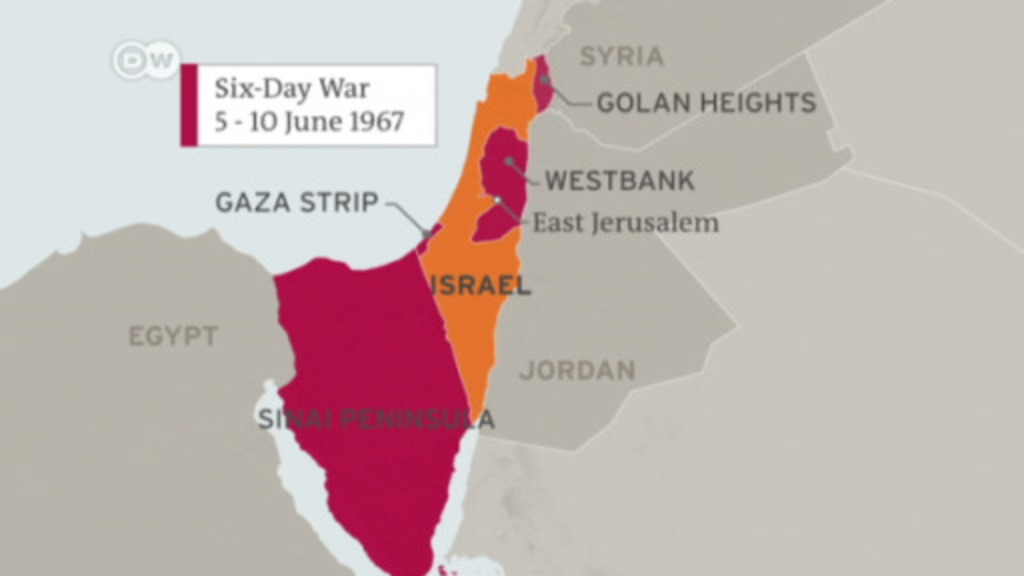The Israeli military on Thursday said Iranian forces in Syria had shelled Israeli army outposts in Golan Heights.
The army said Iran's military fired 20 rockets at Israeli front-line military positions.
Read more: What foreign powers want from the Syrian war
The attack came one night after Syria accused Israel of striking one of its military bases south of Damascus, which the Britain-based Syrian Observatory for Human Rights said killed 15 people including eight Iranians.
Read more: Opinion: 1967 - The war that never ended
Israel's military spokesman Lieutenant Colonel Jonathan Conricus said Iran's Al Quds force fired the rockets at several Israeli bases, though he would not say how Israel determined the Iranian involvement.
The incoming attack triggered air raid sirens in the Israeli-controlled Golan Heights, which was captured from Syria in the 1967 Six-Day war and was annexed by Israel in 1981.
Read more: Damascus residents reveal how Syria's conflict has altered their lives
Israeli war planes target Syria
The incident follows an increase in tensions between Israel and Syria, where Iranian and Lebanese Hezbollah forces have been helping Damascus to fight rebels in a 7-year-old conflict.
Conricus said Israel had retaliated for the attack on its outposts in the strategic Golan Heights plateau, which it partly occupies, without providing further details.
Read more: US-led strikes on Syria: A move with unpredictable consequences
The Syrian military was later quoted as saying its air defenses had confronted Israeli rocket fire on its territory, according to state media.
Syrian state news agency SANA reported that Israeli warplanes had targeted Syrian territories with rockets and that Syrian air defenses had responded.
Read more: Opinion: Where the West has gone wrong in Syria's civil war
SANA reported that the Israeli warplanes were shooting the rockets from inside the occupied Palestinian territories and targeting the City of Baath in Quneitra province, which was shelled shortly after midnight.
-
A history of the Middle East peace process
UN Security Council Resolution 242, 1967
United Nations Security Council Resolution 242, passed on November 22, 1967, called for the exchange of land for peace. Since then, many of the attempts to establish peace in the region have referred to 242. The resolution was written in accordance with Chapter VI of the UN Charter, under which resolutions are recommendations, not orders.
-
A history of the Middle East peace process
Camp David Accords, 1978
A coalition of Arab states, led by Egypt and Syria, fought Israel in the Yom Kippur or October War in October 1973. The conflict eventually led to the secret peace talks that yielded two agreements after 12 days. This picture from March 26, 1979, shows Egyptian President Anwar Sadat, his US counterpart Jimmy Carter and Israeli Prime Minister Menachem Begin after signing the accords in Washington.
-
A history of the Middle East peace process
The Madrid Conference, 1991
The US and the former Soviet Union came together to organize a conference in the Spanish capital city of Madrid. The discussions involved Israel, Jordan, Lebanon, Syria, and Palestinians — not from the Palestinian Liberation Organization (PLO) — who met with Israeli negotiators for the first time. While the conference achieved little, it did create the framework for later, more productive talks.
-
A history of the Middle East peace process
Oslo I Accord, 1993
The negotiations in Norway between Israel and the PLO, the first direct meeting between the two parties, resulted in the the Oslo I Accord. The agreement was signed in the US in September 1993. It demanded that Israeli troops withdraw from West Bank and Gaza and a self-governing, interim Palestinian authority be set up for a five-year transitional period. A second accord was signed in 1995.
-
A history of the Middle East peace process
Camp David Summit Meeting, 2000
US President Bill Clinton invited Israeli Prime Minister Ehud Barak and PLO Chairman Yasser Arafat to the retreat in July 2000 to discuss borders, security, settlements, refugees and Jerusalem. Despite the negotiations being more detailed than ever before, no agreement was concluded. The failure to reach a consensus at Camp David was followed by renewed Palestinian uprising, the Second Intifada.
-
A history of the Middle East peace process
The Arab Peace Initiative, 2002
The Camp David negotiations were followed first by meetings in Washington and then in Cairo and Taba, Egypt — all without results. Later the Arab League proposed the Arab Peace Initiative in Beirut in March 2002. The plan called on Israel to withdraw to pre-1967 borders so that a Palestinian state could be set up in the West Bank and Gaza. In return, Arab countries would agree to recognize Israel.
-
A history of the Middle East peace process
The Roadmap, 2003
The US, EU, Russia and the UN worked together as the Middle East Quartet to develop a road map to peace. While Palestinian Prime Minister Mahmoud Abbas accepted the text, his Israeli counterpart Ariel Sharon had more reservations with the wording. The timetable called for a final agreement on a two-state solution to be reached in 2005. Unfortunately, it was never implemented.
-
A history of the Middle East peace process
Annapolis, 2007
In 2007 US President George W. Bush hosted a conference in Annapolis, Maryland, to relaunch the peace process. Israeli Prime Minister Ehud Olmert and Palestinian Authority President Mahmoud Abbas took part in talks with officials from the Quartet and over a dozen Arab states. It was agreed that further negotiations would be held with the goal of reaching a peace deal by the end of 2008.
-
A history of the Middle East peace process
Washington, 2010
In 2010, US Middle East Envoy George Mitchell convinced Israeli Prime Minister Benjamin Netanyahu to agree to and implement a ten-month moratorium on settlements in disputed territories. Later, Netanyahu and Abbas agreed to relaunch direct negotiations to resolve all issues. Negotiations began in Washington in September 2010, but within weeks there was a deadlock.
-
A history of the Middle East peace process
Cycle of escalation and ceasefire continues
A new round of violence broke out in and around Gaza late 2012. A ceasefire was reached between Israel and those in power in the Gaza Strip, which held until June 2014. The kidnapping and murder of three Israeli teenagers in June 2014 resulted in renewed violence and eventually led to the Israeli military operation Protective Edge. It ended with a ceasefire on August 26, 2014.
-
A history of the Middle East peace process
Paris Summit, 2017
Envoys from over 70 countries gathered in Paris, France, to discuss the conflict between Israelis and Palestinians. Netanyahu slammed the discussions as "rigged" against his country. Neither Israeli nor Palestinian representatives attended the summit. "A two-state solution is the only possible one," French Foreign Minister Jean-Marc Ayrault said at the opening of the event.
-
A history of the Middle East peace process
Deteriorating relations in 2017
Despite the year's optimistic opening, 2017 brought further stagnation in the Israeli-Palestinian peace process. A deadly summer attack on Israeli police at the Temple Mount, a site holy to both Jews and Muslims, sparked deadly clashes. Then US President Donald Trump's plan to move the embassy to Jerusalem prompted Palestinian leader Abbas to say "the measures ... undermine all peace efforts."
Author: Aasim Saleem
law/rc (AP, Reuters)





















